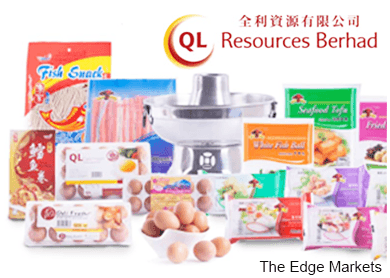
KUALA LUMPUR: The ringgit has fallen sharply, but not QL Resources Bhd’s earnings as its diversified core businesses have provided a natural hedge for each other.
Managing director and founder Dr Chia Song Kun said that QL Resources “hasn’t put all its eggs in the same basket”.

The export of fish-based surimi products is earning US dollars, which helps to offset any adverse impact that QL Resources may have on the weaker ringgit, such as the importing of feed for its livestock farming, he explained.
“In this challenging environment, it is quite good that we can still grow our profits and our margins,” said Chia at a press conference after the group’s annual general meeting yesterday.
On QL Resources’ bid for Lay Hong Bhd, Chia brushed off speculation that the group would make a renewed bid for the poultry farming firm at a higher price, following a failed takeover bid last year.
However, he noted that QL Resources was assessing its options, which may include selling off its 38% stake in Lay Hong because it has no board representation. Lay Hong’s share price remains high at RM3.50 — the price which QL Resources had offered to buy out the poultry firm.
Back on QL Resources’ financial performance, for the first quarter ended June 30, the group managed to post a profit of RM40.93 million, a slight 1.4% growth from the previous corresponding quarter, dragged down by the livestock and palm oil divisions, but offset by the marine product manufacturing (MPM) arm.
So far, the fall in the ringgit is manageable due to the group’s complex structure that creates a natural hedge for currency fluctuations, said Chia.
The group’s revenue from its MPM arm rose by 9% year-on-year (y-o-y) to RM186.46 million in the quarter, while profit before tax (PBT) for the segment shot up by 33%.
Chia attributes this to the fact that QL Resources exports up to 60% of its MPM products, which consists of fishmeal and surimi, while the bulk of the costs is in ringgit. Hence, the segment directly benefits from the weak ringgit.
Meanwhile, the group’s integrated livestock farming (ILF) business saw PBT fall by 30% y-o-y to RM13.03 million, while revenue remained relatively flat at RM378.89 million.
The poor results in the segment had little to do with the weak ringgit. Note that about 60% to 70% of the raw material costs for livestock feed is incurred in US dollars. Like most poultry players, QL Resources has to import its corn and soybean, which is priced in US dollars.
“While the ringgit has depreciated, the price of corn and soybean have also fallen due to a bumper crop in the US. As a result, the net impact [on the ILF division] has been neutral,” explained Chia.
Instead, the ILF segment’s drop in profitability stems from a shipment delivery of feed raw materials, as well as poor poultry farm produce prices. Furthermore, the group’s raw material trading saw lower margins.
“There was a glut in chicken eggs in May, June and July. But the cycle for the industry is very short — about six months. Now, we no longer have an oversupply situation,” said Chia.
He also points out that eggs are still the cheapest source of protein available, at “only 35 sen an egg or about RM6 to RM7 for one kilogram”. Hence, eggs would be relatively “recession proof” during an economic slowdown.
As long as the ringgit averages between 4.0 and 4.2 against the US dollar, there should be a neutral impact on earnings, said Chia. But anything beyond that, and there may be a negative impact, he added
QL Resources’ share price seems to be resilient. The stock regained some lost ground to close at RM3.90 yesterday after it had dropped from the peak of RM4.25 early this month to a low of RM3.80.
This article first appeared in digitaledge Daily, on August 28, 2015.